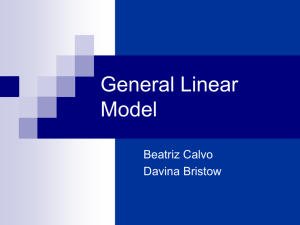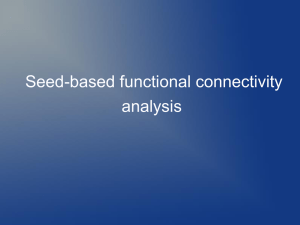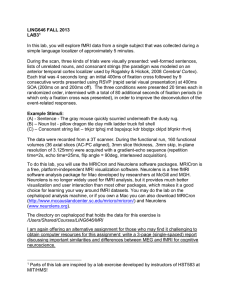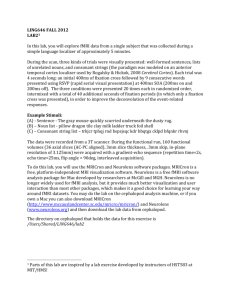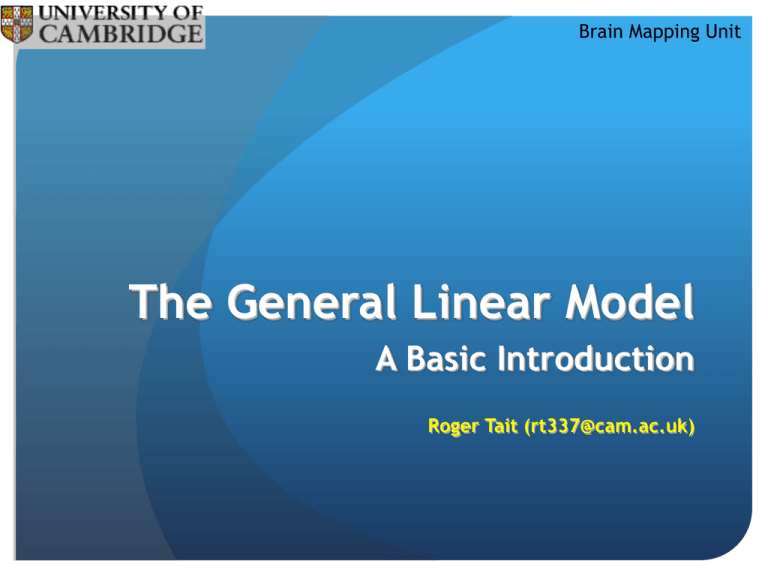
Brain Mapping Unit
The General Linear Model
A Basic Introduction
Roger Tait (rt337@cam.ac.uk)
Brain Mapping Unit
Overview
What is imaging data
How is data pre-processed
Hypothesis testing
GLM: simple linear regression
Analysis software
How to process results
Brain Mapping Unit
What is imaging data?
Brain Mapping Unit
Data
A stack of numbers
Structural
fMRI
Functional
Brain Mapping Unit
Multiple Data
subjID
voxel1
voxel2
voxel 3
voxel 4
…….. voxel n
1
1227.308541 1472.770249 1417.745632 1701.294758
1288.742729
2
1612.461523 1934.953827 1677.661927 2013.194312
1465.051592
3
1466.264739 1759.517687 1559.769586 1871.723503
1827.678127
4
1499.70072 1799.640864 1842.474418 2210.969302
1316.392368
5
1598.121692 1917.746031 1510.850757 1813.020909
1740.286976
6
1408.066243 1689.679492 1399.393815 1679.272578
1534.459154
7
1555.951487 1867.141784 1588.529211 1588.529211
1516.464089
8
1397.721831 1677.266197 1523.825912 1523.825912
1340.814881
9
1333.659118 1600.390941 1384.217926 1384.217926
1461.281399
10
1453.14966 1743.779592 1558.603977 1558.603977
1406.575083
Brain Mapping Unit
Reorientation
Native
Reoriented
MNI152
Brain Mapping Unit
Basic pre-processing (fmri)
omprage.nii
obrain.nii
omrest.nii
nomrest.nii
worest.nii
wnomrest.nii
Brain Mapping Unit
Basic pre-processing (structural)
omprage.nii
gmomprage.nii
wgmomprage.nii
Brain Mapping Unit
How does standard space data
help?
Brain Mapping Unit
Hypothesis testing
Statistical inference is commonly done with a test
statistic (t, F, c2…) which has a distribution under
H0 mathematically derived.
For example
^b1 ^b0
t=
t
^1 ^b0)
SE(b
5%
Parametric Null Distribution
NB: this assumes that the errors
are independent and normally
distributed.
Brain Mapping Unit
Introducing The GLM
Y = Xb + e
DATA = MODEL + ERROR
DATA = KNOWN * UNKNOWN + ERROR
Encapsulates: t-test (paired, un-paired), F-test, ANOVA
(one-way, two-way, main effects, factorial) MANOVA,
ANCOVA, MANCOVA, simple regression, linear
regression, multiple regression, multivariate
regression……
Brain Mapping Unit
GLM definition
Y = Xb + e
Where Y is a matrix with a series of observed
measurements
Where X is a matrix that might be a design matrix
Where b is a matrix containing parameters to be
estimated
And e is a matrix containing error or noise
Brain Mapping Unit
GLM: Simple Linear Regression
Y = b0 + X1b1 +
e
b0: is the Y axis intercept
Y
b1: is the gradient of slope
Y: the black circles
e: diff between
X
predicted Y and
observed Y
Brain Mapping Unit
GLM: Simple Linear Regression
Y = b0 + X1b1 + e
^
^
This is done by choosing b0 and b1 so that the sum of
the squares of the estimated errors S ei2 is as small
as possible.
This is called the Method of Least Squares.
S ei2 is called the Residual Sum of Squares (RSS)
Brain Mapping Unit
GLM example
DATA = KNOWN * UNKNOWN + ERROR
= mean reaction time + GENDER + AGE
Y = b0 + X1b1 + X2b2+ X3b3+ X4b4+ e
Brain Mapping Unit
Dummy Variables
Continuous variables
measurements on a continuous scale (age,
mRT)
(-4.01, -0.47, 6.35, -7.06, -7.69, -14.24)
Dummy Variables
Code for group membership (disease, gender)
controls = 0, patients = 1
females = 1, males = -1
Brain Mapping Unit
Usage
Hypothesis tests with GLM can be multivariate or
several independent univariate tests
In multivariate tests the columns of Y are tested
together
In univariate tests the columns of Y are tested
independently (multiple univariate tests with the
same design matrix)
Brain Mapping Unit
fMRI model specification
silent naming task
The model
BOLD signal
Brain Mapping Unit
Actual retrieved data
30
20
10
Model
0
+ve activation
0
-10
-20
-30
50
100
150
200
250
300
350
400
450
500
-ve activation
Brain Mapping Unit
fmri analysis with FSL
Brain Mapping Unit
Structural analysis with CamBA
sex
group
weight
Brain Mapping Unit
Structural analysis output
Brain Mapping Unit
Where are my clusters?
here is a big
cluster
here is a big
cluster
Brain Mapping Unit
Where is the cluster I am
interested in?
position mouse
cursor here
cluster
location
information
shown here
Brain Mapping Unit
How do my clusters help me?
Brain Mapping Unit
Statistical Testing
Convert cluster into a binary mask
Overlay mask on subject data
Extract voxel intensities
Do some statistical analysis to get more information
from your data
Brain Mapping Unit
Correlation with behaviour
for cluster Pos_002
p>0.05
close but cluster
Pos_001 does not
significantly
correlate with
behaviour HIT1
Brain Mapping Unit
Other Analyses
different from 0
one-sample t-test
Difference between means
two-sample t-test
Linear relationship between 2 variables
simple regression
Brain Mapping Unit
What else can I do to find out
more about my data?
Brain Mapping Unit
Other types of analyses
Factorial designs
Permits analysis of multiple time data
Shows
Main effects of Factor 1 (time)
Main effects of Factor 2 (group)
Interaction between Factor 1 and Factor 2
Brain Mapping Unit
Useful software package
CamBA – Cambridge
http://www-bmu.psychiatry.cam.ac.uk/software/
FSL Randomise – Oxford
http://fsl.fmrib.ox.ac.uk/fsl/fslwiki/Randomise
SPM8 – UCL
http://www.fil.ion.ucl.ac.uk/spm/software/spm8/
Brain Mapping Unit
In summary
The GLM allows us to summarize a wide variety of
research outcomes by specifying the exact equation
that best summarizes the data for a study. If the
model is wrongly specified, the estimates of the
coefficients (the beta values) are likely to be biased
(i.e. wrong) and the resulting equation will not
describe the data accurately.
In complex situations (e.g. cognitive fMRI paradigms),
this model specification problem can be a serious and
difficult one
Brain Mapping Unit
Any questions?




